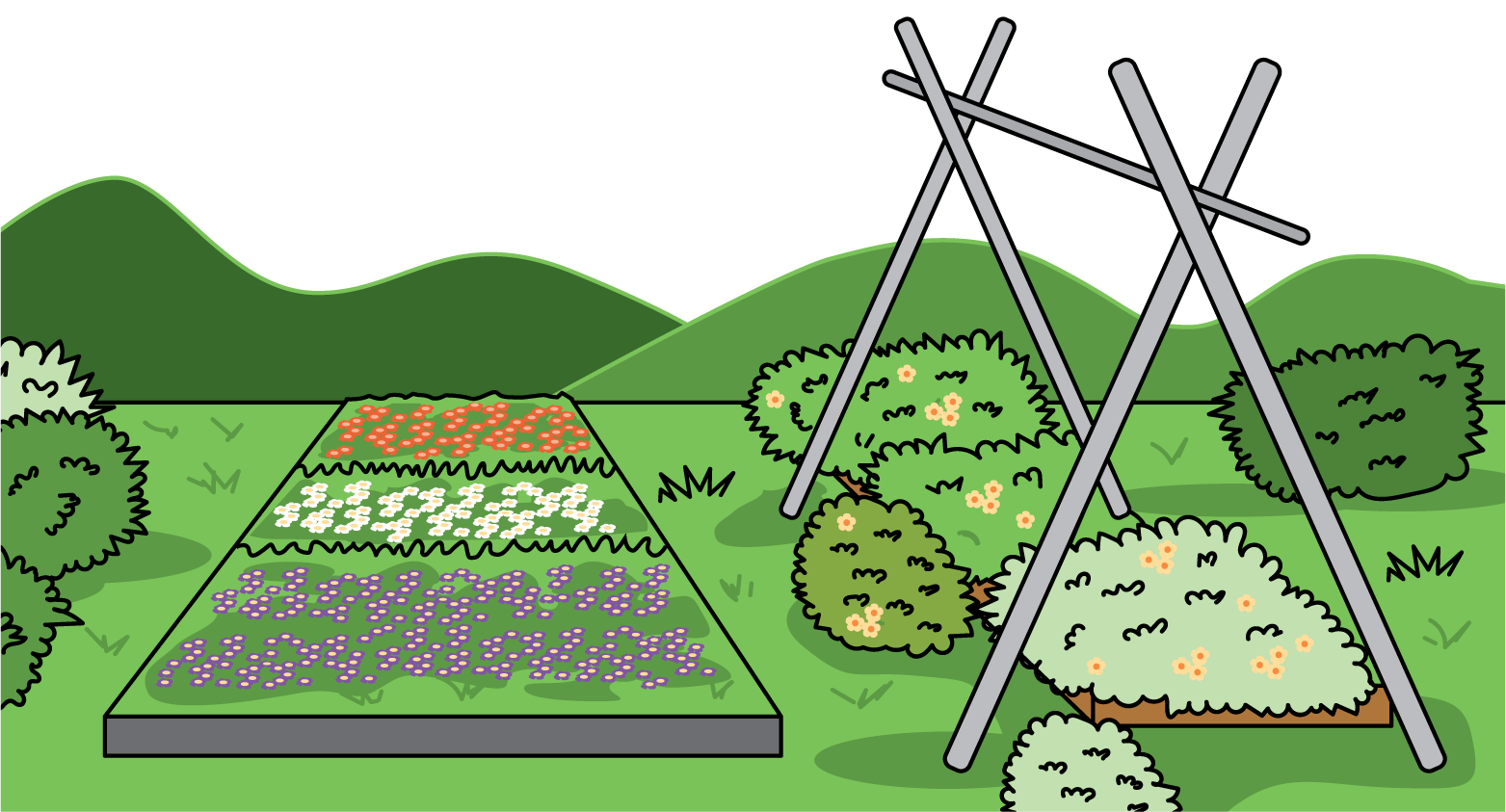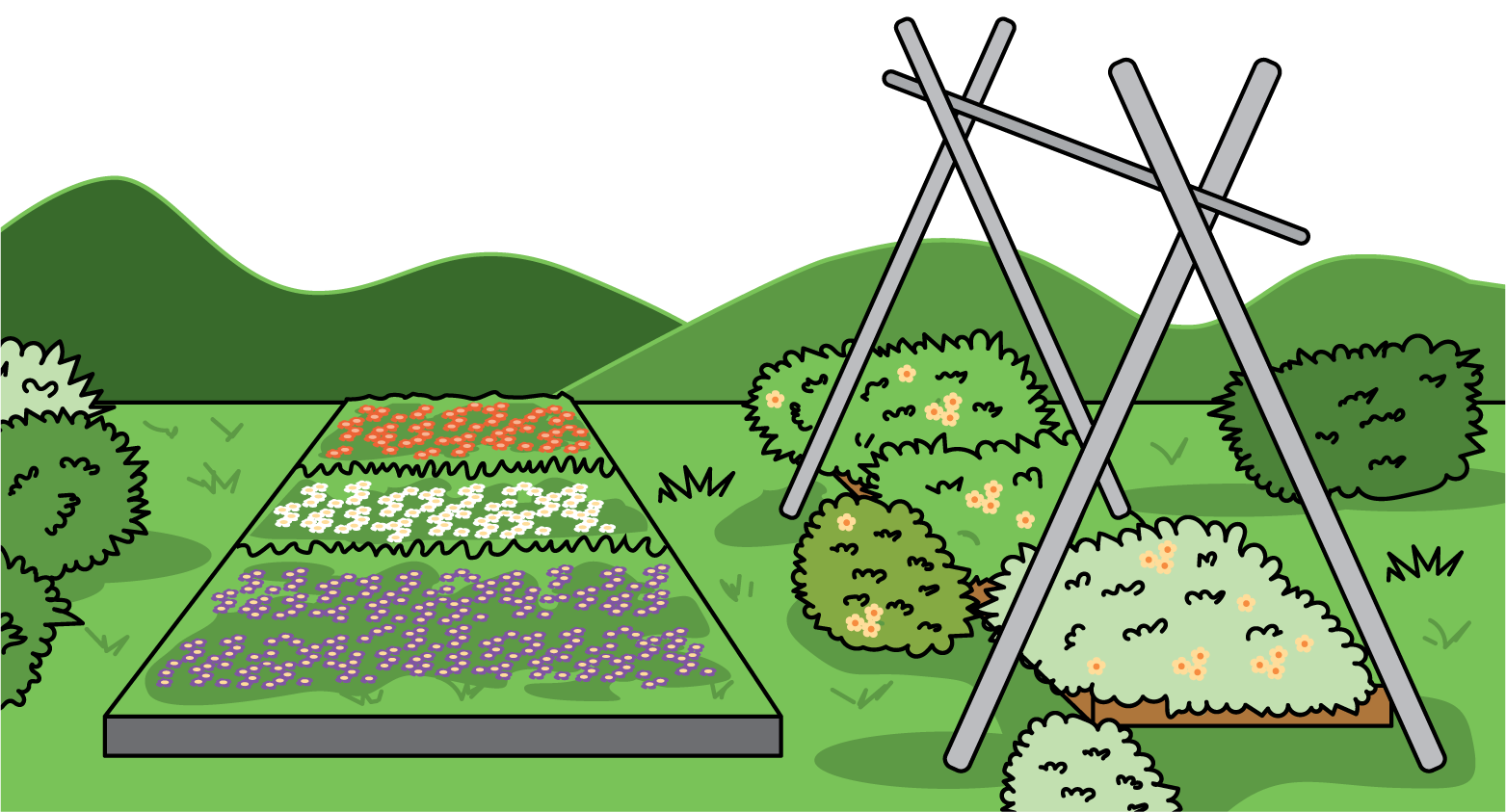Lesson 16
Estimate Products (optional)
Warm-up: Notice and Wonder: Garden Size (10 minutes)
Narrative
The purpose of this warm-up is for students to reason about the side lengths of a garden with a given area in preparation for an upcoming activity. If students do not name any fractional side lengths, ask the synthesis question to prompt that discussion.
Launch
- Groups of 2
- Display the image.
- “What do you notice? What do you wonder?”
- 1 minute: quiet think time
Activity
- “Discuss your thinking with your partner.”
- 1 minute: partner discussion
- Share and record responses.
- “If the garden is between 30 square feet and 40 square feet, what are some possible side lengths?” (Sample responses: 8 feet by 4 feet, 7 feet by 5 feet)
- Share and record responses.
Student Facing
What do you notice? What do you wonder?

Student Response
For access, consult one of our IM Certified Partners.
Activity Synthesis
-
“Would side lengths of 10 feet and \(3 \frac{1}{8}\) feet be possible based on the area?” (Yes because 10 times 3 is 30 and since \(10 \times \frac{1}{8}\) is more than 1 but less than 2, so the area would be more than 30 but less than 40.)
Activity 1: Priya’s Garden (20 minutes)
Narrative
The purpose of this activity is for students to notice and use the structure in multiplication expressions to represent the area of rectangles. Students estimate products to see if they are greater than or less than a given amount to solve a problem. Remind students they can draw a diagram if it is helpful.
Advances: Reading, Writing
Supports accessibility for: Conceptual Processing, Organization
Launch
- Groups of 2
- Display image from student book:

- “What do you know about gardens?”
Activity
- 2–3 minutes: independent work time
- 6–7 minutes: partner discussion
- Monitor for students who:
- draw diagrams.
- estimate the approximate area.
- reason which gardens are less than 36 square feet and which ones are bigger than 36 square feet.
Student Facing

Priya has enough materials to build a garden that is 36 square feet.
Choose all the side lengths that are reasonable for her garden. Be prepared to explain your thinking to your partner.
- 9 feet by \(4 \frac{2}{3}\) feet
- 9 feet by \(3 \frac{8}{9}\) feet
- 12 feet by \(2 \frac{11}{12}\) feet
- 9 feet by \(2 \frac{2}{3}\) feet
Student Response
For access, consult one of our IM Certified Partners.
Advancing Student Thinking
Activity Synthesis
- Ask previously selected students to share how they know that two of the expressions will have values a little bit less than 36. (I know that \(9 \times 4 = 36\) and \(3\frac{8}{9}\) is a little less than 4. I know that \(12 \times 3 = 36\) and \(2 \frac{11}{12}\) is a little less than 3.)
Activity 2: Too High, Too Low, Just About Right (15 minutes)
Narrative
In the previous activity, students reasoned about the value of each product by thinking about the decomposition of the mixed number factor, and how close the mixed number is to the nearest whole number. The purpose of this activity is for students to reason about the value of products by rounding either the whole number or mixed number factors and multiplying.
When students try to make a product close to 20 using the given digits, they will rely on number sense but also may need to experiment and refine their choices and strategy after finding the value of the product (MP1).
Launch
- Groups of 2
Activity
- 5–8 minutes: independent work time
- 1–2 minutes: partner discussion
- Monitor for students who:
- Multiply the whole numbers in problem 1 to find their product that is too low.
- Round the mixed number factor to the nearest whole number before multiplying to find the just right estimate.
Student Facing
- Write a whole number product that is slightly less than, slightly greater than, or about equal to the value of \(7 \times12\frac89\).
- slightly less:
- slightly greater:
- just right:
- Write a whole number product that is slightly less than, slightly greater than, or about equal to the value of \(9 \times4\frac{2}{29}\).
- slightly less:
- slightly greater:
- just right:
- Without calculating, use the numbers 2, 3, 5, 6, and 7, to complete the expression with a value close to 20.
\(\underline{\hspace{1 cm}}\times\underline{\hspace{1 cm}}\frac{\boxed{\phantom{\frac{aaai}{aaai}}}}{\boxed{\phantom{\frac{aaai}{aaai}}}}\) - Explain how you know your expression represents a value close to 20.
Student Response
For access, consult one of our IM Certified Partners.
Activity Synthesis
- Ask selected students to share.
- Consider asking:
- “What strategies did you determine the just right product?” (I rounded the mixed number to a whole number based on the size of the fraction and multiplied.)
- “In the third problem, is your product more, less, or equal to 20? How do you know?”
Lesson Synthesis
Lesson Synthesis
“Today we made reasonable estimates for the value of multiplication expressions and used what we know about the properties of operations to find the value of the expressions.”
Display:
\((5 \times 4) - (5 \times \frac {1}{4})\)
- 20
- 19
- 16
“What is a reasonable estimate for the value of this expression?” (19 because we are subtracting a little bit more than one from 20. This means 20 is too high and 16 is too low.)
Display:
\((5 \times 4) - (5 \times \frac {1}{4}) = (5 \times 3) + (5 \times \frac {3}{4})\)
“How do we know this equation is true?”
(Both expressions are equivalent to \(18 \frac{3}{4}\). Some will notice both can be rewritten as \(5 \times 3 \frac {3}{4}\).)
Cool-down: Estimate and Solve (5 minutes)
Cool-Down
For access, consult one of our IM Certified Partners.
Student Section Summary
Student Facing
In this section, we learned how to find the area of a rectangle with a fractional side length. The shaded region has an area of \(4 \times \frac {2}{3}\) because there are 4 groups of \(\frac{2}{3}\) of a square unit shaded. The area is \(\frac {8}{3}\) or \(2 \frac{2}{3}\) because there are 8 shaded parts and each one is \(\frac{1}{3}\) of a square unit.

We also learned to multiply a mixed number by a whole number. We used area diagrams and expressions to see why our strategies work. For example, to solve \(3 \frac {3}{4} \times 2\), we can use the expression \((3 \times 2) + ( \frac {3}{4} \times 2)\). We can see both of these expressions in the diagram.
